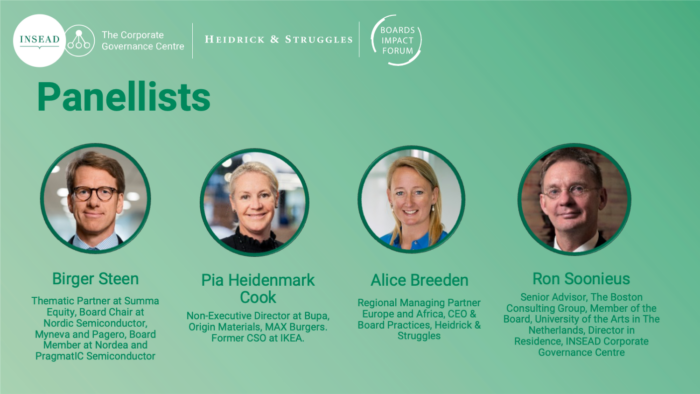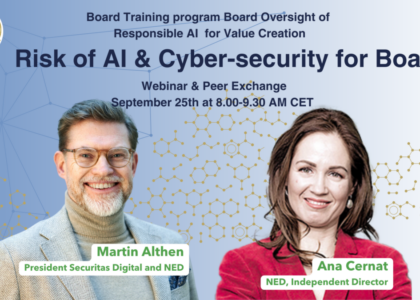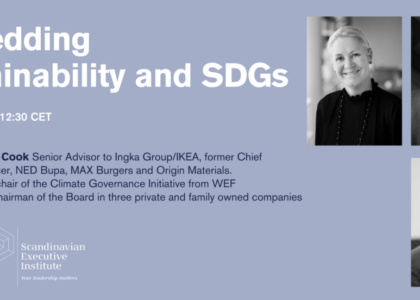How do boards address decarbonization and to what extent are climate change priorities integrated into boards’ oversight responsibilities? A webinar which Boards Impact Forum hosted together with INSEAD Corporate Governance Centre, ICGC, and Heidrick & Struggles provided insight into this.

- There’s a clear disconnect between what board members say about the importance of climate change and the actions taken
- Boards need to work both with value creation and compliance
- Integrate sustainability into every business planning and strategic process
- Make sure to understand your value chain and the full impact the organization has
- Assure to spend time, and resources, on the correct things and add incentives
- Every board member needs to bring these issues to their specific board rooms alongside with both insights and hope
Recent research on the topic was presented by Alice Breeden (Heidrick & Struggles) and Ron Soonieus (INSEAD and Boston Consulting Group). The findings reveal a clear disconnect between what board members say about the importance of climate change and the actions taken by their companies. The presentation followed an interactive panel with Chair & NED Birger Steen (Nordea, Nordic Semiconductor, Myneva Group, Pagero and partner Summa Equity) and NED Pia Heidenmark Cook (Bupa, Origin Materials, Max Burgers, and former Chief Sustainability Officer at IKEA). Moderated by Sonia Tatar, Executive Director INSEAD ICGC.

The Panel Discussion on “Changing the Climate in the Board Room” brought forward some key insights summarized below.
Expectations on businesses as a force for good has increased substantially. At the same time stakeholders don’t believe that business is doing enough when it comes to climate change, economic inequalities and workforce rescaling.
“The research shows that there is a big interest and understanding among board members that they need to tackle these complex issues.” – Alice Breeden, Partner Heidrick & Struggles
There is a desire for more knowledge and better reporting. There is also uncertainty on how to actually address the issues, set the targets and action plans and then how to implement them (see Changing the Climate in the Boardroom paper).
“Most boards understand the complexity and either focus on the reporting and compliance side or on the opportunity side, whereas you need to work both with value creation and compliance in an integrated way.“– Birger Steen, Chair
For many, climate is still a new topic, there is a need to understand. It’s easy to limit your attention to reporting and compliance. To make a difference you need to find the opportunities.
For climate, we now have a good framework for reporting, setting Science Based Targets and strategy. These have evolved over the past 20 years. Expect to see further development in that area as well as on the social side. We will build and learn continuously. In particular, in regard to scope three i. e, how you impact your greater ecosystem, your suppliers’ impact and how your customers are using your products and the impact of that use. These issues are not covered by the financial reporting so there is still a lot of learning ahead of us. We also need to take the time to reflect on what the facts are telling us.
“Concerning materiality, you have to understand your value chain and the full impact the organization has. Where can you contribute the most and where are the risks? “- Pia Heidenmark Cook, NED
The aspects that are material are those important for your business. Thus, not ESG vs profit, instead they go together. Not necessarily so easy, but in many ways common sense if you really reflect on your business and its impact, both positive and negative. Sustainability is about stakeholder capitalism. What is important to your employees, your owners, your customers, your suppliers? Reflect on where you can have the biggest impact, or potential impact, to change and contribute. Combine that with the risks in a matrix and start prioritizing. Make a plan to divide into smaller pieces and start measuring.
Do we spend time, and resources, on the correct things? Start the conversation and add a link to the incentives you have. Incentives do matter and will initiate a good conversation.
Where to start?
A good way to start is to build on stakeholder insights and materiality analysis. We also recommend that you do an inventory of what the company already is doing. Most organizations are already active, be it HR practices, community engagement, dialogue with suppliers. Then you can build on that and extend your work. Discuss HR practices with your suppliers etc. Many companies have worked on saving energy, water and improved operations. Again, expand that discussion to your suppliers, and to your customers. Put all these pieces together so that you get the full picture of what you already do and what you need to work more on.
Learning from the IKEA story, you will get results when you analyze your value chain and identify specific opportunities to eliminate waste or other negative externalities along your entire value chain, both suppliers and your own impact on your customers.
“The key thing is tointegrate sustainability into every business and strategic planning process within the company.” – Ron Soonieus, INSEAD and BCG.
Look at the issue with a five-to-ten-year horizon, but also with a one year target. The beauty is that this is complex, a lot of hard work and so exciting that it keeps changing and you can never rest on your laurels. Do not wait for all the different pieces to fall in place, when you identified what needs to change, go ahead and change them, don’t wait for the perfect timing.
Regarding the composition of boards and board work, board work is expanding in both scale and scope. That means you need to have different types of people on the board and more people that are full time board members. For sustainability we want everyone to know enough and to be part of everything the company is doing.
“The key factor is that every board member brings these issues to their specific board rooms and that you bring both insights and hope” – Liselotte Engstam, Chair & NED
To learn more and join Boards Impact Forum
The recording from the webinar can be found here
Upcoming webinars at Boards Impact Forum Our Events – Boards Impact Forum
Joining as a member or to receive the newsletter Join the Forum – Boards Impact Forum







Recent Comments